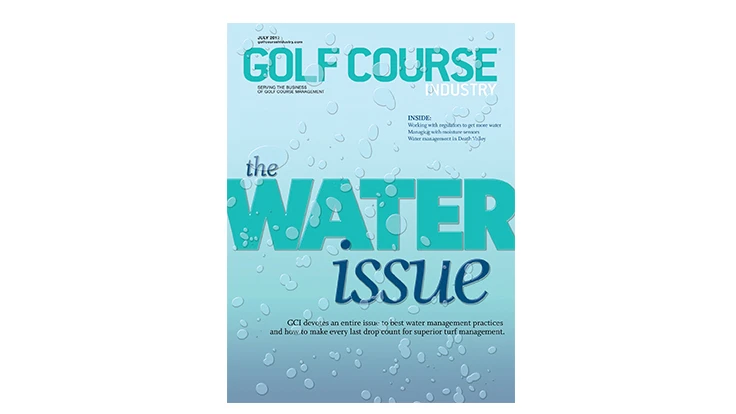
 Much of the industry faced a nearly non-existent winter with a quick, non-transitional period into warm summer-like weather far earlier than normal this year. While the weather variable alone will add to the complexity of seasonal challenges, one variable, soil moisture, will be a key indicator for many ailments or rewards you will encounter as the season progresses.
Much of the industry faced a nearly non-existent winter with a quick, non-transitional period into warm summer-like weather far earlier than normal this year. While the weather variable alone will add to the complexity of seasonal challenges, one variable, soil moisture, will be a key indicator for many ailments or rewards you will encounter as the season progresses.
Some of you are witnessing the effects of poor and good soil moisture management from earlier this year. Those not able to dry out their turf early saw the development of early season disease pressures and slow uptake of nutrients in saturated conditions. On the other hand, those who had minimal soil moisture but started operations later due to calendar or labor restraints missed a golden opportunity to jump start the growing season and build early energy reserves in the turf, which will help in the summer months.
Temperature excluded, soil moisture is the single most important factor that affects the physiology of your turf and its growth habit as the season progresses. Ironically, moisture has a tremendous impact on temperature in the soil and the turf canopy.
Why we monitor. Early turf educational lectures taught us that a perfect soil is one where there is an optimal balance of soil moisture, air and gas that leads to strong turf growth. This is particularly true for growth under the typical stresses of golf course management. It is the reason why USGA specifications call for a high sand content mix to develop high quality putting greens, tees and other areas where compaction leads to loss of turf.
Even under packed conditions, these mixes maintain a quality level of soil moisture, air and gas. As a soil gets heavier…that is, less sand with a higher amount of smaller particles and therefore more compaction…we typically find less air and more water which leads to more compaction as we put traffic on these soils.
Those with “runway” type cart paths know exactly what I am talking about. The concentrated traffic of carts in these areas causes excessive compaction, especially under higher than optimal moisture conditions. This unfortunately was noticed much earlier this year due to the extended season with the early onset of traffic.
|
Predictive solutions Over the past decade, I have had the opportunity to monitor many variables in the soil and above ground through many regions around the world. As a result, I have written many predictive solutions and algorithms that draw on the changing variables affecting turf daily and throughout the season. A key variable in these predictive models is soil moisture. For instance, too much moisture leads to moisture stress. Too high of a temperature leads to temperature stress. The combined effects of temperature and moisture, however, are much more important to the turf manager. Throw in salts and the needs and limitations of the turf with regard to water change dramatically. The key is knowing how much impact any one variable has on the target we are after. These targets include stress, disease likelihood, recuperative capacity, playability and performance, aesthetic quality and a whole slew of other things. Moisture has a significant weighted impact compared to many other variables. Also, when we consider that the finest turfgrass performance comes when the grass is almost on the brink of dying, any slight change in management that affects moisture in either direction will have an impact on whether our players are happy or not with the performance on the golf course on any given day. |
Soil moisture triggers many physiological responses in the turf plant. For one, turf cannot chew its food. It depends on dissolved nutrients in solution, including dissolved oxygen, to function properly. Even the fundamental process of respiration where the roots utilize soil oxygen is greatly affected when soil moisture levels are too high. The byproduct of respiring in low oxygen conditions is the production of ethanol and a buildup of soil CO2. Ethanol alone is very toxic to turf while the buildup of soil CO2, particularly when it cannot escape from the soil leads to exponential declines in turf activity as oxygen becomes more and more limiting.
As the ambient temperature rises and a condition of photorespiration kicks in – a process where oxygen replaces the desired carbon dioxide in photosynthesis – a much less efficient plant growth process produces a net loss of carbon and nitrogen with ammonia as the by-product of the latter. Both slow plant growth processes including those that we depend on to survive the stresses of play conditioning. While C4 or warm season grasses have a storage mechanism for basically storing CO2 so that the plant can remain efficient even in hot temperatures, having excess moisture in the soil leads to similar declines in growth no matter what type of grass you are growing.
With regard to the uptake of those dissolved nutrients, this process is impacted by the plant’s fundamental growth patterns. If it is not photosynthesizing or respiring efficiently, it simply is not taking up nutrients well or at all. However, positioning key nutritional elements through foliar feeding is proving to have a positive impact on jump starting certain plant growth processes even under stress (another topic for another article). Finally, in soil where moisture is kept higher than optimal, we often see black layer form.
Many think black layer forms from using too much sulfur based fertilizers. The truth is that only under anaerobic conditions can black layer form. The microbes that cause black layer function in anaerobic or low oxygen soils where they attack and feed on sulfur based compounds and leave behind a fine black oxide particle that bonds with soil particles and clogs soil pores. This problem gets worse and worse until oxygen is introduced in which case the anaerobic-loving microbes cannot function any longer.
In every case above, monitoring soil moisture on a regular basis will have a positive impact and allow for the best chances of integrating a pest, stress and conditioning management program that is sure to keep golf course superintendents, members and players happy…something that is not easily achieved on a regular basis.
Monitoring methods. Many superintendents have found a way to use their thumbs, a knife, a coring tool or some way of monitoring the moisture on a routine consistent basis.
Today, there are options that have taken soil monitoring to a level of precision we only dreamed about a decade ago. I am amazed at how far technology has come in such a short time. In my early work for UgMo, where I served as chief agronomist, I coordinated how to utilize the information that sensors give us, I was able to put well-defined models to use in real time. One example was the ability to predict seedhead emergence by narrowing the window of this physiological effect to less than 48 hours compared to the 7- to 10-day window previously achieved with above ground only growing degree day models. Of course, any predictive model depends on the proper quantity and location of sensors to make sense. For those of you waiting for the technology to become affordable, your time is fast approaching so keep your eyes open for updates coming your way very soon.
But short of investing in the new technology to help you with soil monitoring, use your head at the very least. Know what your limitations are with your irrigation and make the necessary adjustments to insure the compromises you make to insure adequate coverage are the right ones that aren’t going to hinder turf by putting too much water into the soil.
Remember that any length of time where the soil moisture level is too high is too much time…even if it is only for a day or night. On the flip side, too little water can initiate a dormancy mechanism that leads to less resiliency at the surface…a condition having a tremendous impact on ball roll and traffic stress resistance.
The best in the business know that achieving that optimal soil condition comes from being on top of that condition day in and day out. Employ whatever practice you can to take control of your soil moisture whether it is hand applications of water when called for or cultural practices designed to help dry out the soil after a rain event. One day of poor moisture conditions will have a negative impact that can last days, weeks or months depending on what the other surrounding conditions are. But at the very least, don’t read into this like fine print.
Moisture management is part of an overall holistic approach to turf management. If you monitor it consistently, your entire program will be impacted by the decisions you make based on that monitoring.
Carmen Magro, CGCS MBA, is chief agronomist/owner of Agronomy Management Solutions and a frequent GCI contributor.

Explore the July 2012 Issue
Check out more from this issue and find your next story to read.
Latest from Golf Course Industry
- Editor’s notebook: Green Start Academy 2024
- USGA focuses on inclusion, sustainability in 2024
- Greens with Envy 65: Carolina on our mind
- Five Iron Golf expands into Minnesota
- Global sports group 54 invests in Turfgrass
- Hawaii's Mauna Kea Golf Course announces reopening
- Georgia GCSA honors superintendent of the year
- Reel Turf Techs: Alex Tessman





